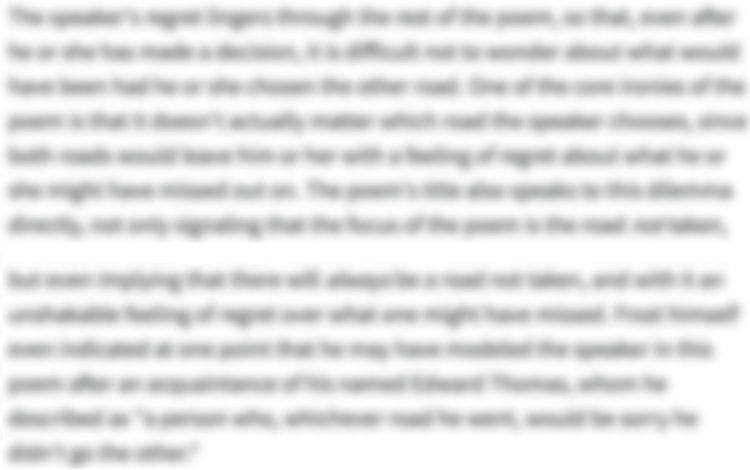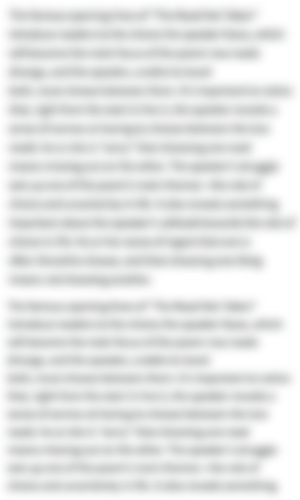The Full Text of “To the Memory of Mr. Oldham”
1Farewell, too little and too lately known,
2Whom I began to think and call my own;
3For sure our souls were near ally'd; and thine
4Cast in the same poetic mould with mine.
5One common note on either lyre did strike,
6And knaves and fools we both abhorr'd alike:
7To the same goal did both our studies drive,
8The last set out the soonest did arrive.
9Thus Nisus fell upon the slippery place,
10While his young friend perform'd and won the race.
11O early ripe! to thy abundant store
12What could advancing age have added more?
13It might (what nature never gives the young)
14Have taught the numbers of thy native tongue.
15But satire needs not those, and wit will shine
16Through the harsh cadence of a rugged line.
17A noble error, and but seldom made,
18When poets are by too much force betray'd.
19Thy generous fruits, though gather'd ere their prime
20Still show'd a quickness; and maturing time
21But mellows what we write to the dull sweets of rhyme.
22Once more, hail and farewell; farewell thou young,
23But ah too short, Marcellus of our tongue;
24Thy brows with ivy, and with laurels bound;
25But fate and gloomy night encompass thee around.
-
“To the Memory of Mr. Oldham” Introduction
-
"To the Memory of Mr. Oldham," John Dryden's elegy for a fellow poet, first appeared in a memorial anthology, Oldham's Remains in Verse and Prose (1684). John Oldham's premature death leaves Dryden dejected: the two poets were just getting to know each other, and Dryden felt as if he might have found a kindred spirit. This poem at once mourns Oldham's demise, celebrates his satirical "force," and pokes fun at his rough-hewn style. No elegy for a satirist, Dryden seems to imply, would feel fitting without a bit of biting mockery.
-
-
“To the Memory of Mr. Oldham” Summary
-
Goodbye to a man whom I met too late to get to know well—whom I was only just starting to consider my dear friend. For our souls were certainly much alike; your poetic tastes and mine could have been made in the same mold. We played the same notes on the lyre of poetry, and we both despised dishonest and foolish people. We worked toward common goals—and though you got started before me, I'm going to reach those goals, where you won't get the chance. In just the same way, in the Aeneid, the soldier Nisus slipped and fell during a footrace, while his young friend Euryalus sprinted ahead and won. Oh, precocious poet! What could more years of life have added to your already remarkable talents? Perhaps, if you'd lived, your poetry might have developed a more elegant meter (which young people never have a knack for). But then, satirical verse doesn't need elegant meter: it's all about wit, and wit can gleam right through an unpolished, jolting line. It's rare for a poet to fail by writing too powerfully, and that's rather a fine mistake to make. The fruits of your poetry, though they were harvested too soon, still revealed your sharp mind—and time only softens poets, making their work sweetly, dully musical. So, once more, I honor you and bid you goodbye: goodbye, you all-too-shortlived warrior of English poetry. Your head is wreathed with the ivy and laurel crowns of immortality and poetic triumph, but cruel destiny and the darkness of death surround you.
-
-
“To the Memory of Mr. Oldham” Themes
-

The Tragedy of a Young Poet's Death
In “To the Memory of Mr. Oldham,” John Dryden elegizes a fellow poet (and a fellow John), John Oldham. Oldham, Dryden laments, was a real kindred spirit, a guy whose perspective on life and art was very much like his own: both of them despised “knaves and fools,” and their art was “cast in the same poetic mould,” shaped to the same tastes and written in a similar sharp, satirical style. Tragically, however, Oldham died young (when he was only 30, in fact). Dryden had only just gotten to know him, “too little and too lately”; he laments not just a lost talent, but a lost opportunity for deep friendship.
If Oldham had lived, Dryden reflects, perhaps this witty but rough-around-the-edges writer would have developed a smoother voice, mastering the “numbers of [his] native tongue” (that is, poetic meter in English). But Dryden also argues that Oldham was a masterful poet even without such metrical fluency. Since Oldham was a satirist, the “harsh cadence” (or rough rhythms) of his poetry suited his mocking, lacerating work better than a more elegant style would have.
In short, where many elegies for poets who died too young lament all the ways in which those poets might have matured, Dryden feels that Oldham was already a mature artist at the time he died. Oldham’s death deprives the world, not of better verse he might have produced as an older man, but simply of more poems! “Advancing age,” Dryden declares, could hardly have “added more” to this already brilliant poet’s work.
However, there's a keen edge on this poem: some of Dryden's compliments sound rather backhanded, and his images of winning a footrace in which Oldham has fallen suggests that he might have felt the slightest bit competitive with his young friend, too. But then, perhaps Dryden felt an elegy for a satirist wouldn't feel right if it didn't have a little bite.
- See where this theme is active in the poem.
-

Poetic Practice and Style
John Dryden’s elegy for his friend and fellow poet John Oldham doesn’t just lament Oldham’s death. It also lays out a pocket summary of Dryden’s attitude toward poetic style. Oldham, like Dryden, was a satirist (that is, a writer of witty, pointed social critiques)—and this, Dryden argues, means that his rather “rugged,” unrefined style was perfectly suited to the kind of poetry he was writing. Poetry’s shape and sound, Dryden suggests, should suit its purposes, and poets should err on the side of “force” over elegance.
If Oldham had lived longer, Dryden remarks, he might have mastered the “numbers of [his] native tongue”—that is, he might have developed a smoother, more flowing way with poetic meter. But really, he didn’t need that kind of voice to do what he was doing. A biting satire, Dryden argues, should be written in a suitably “harsh” and “rugged” voice. A more lyrical older Oldham might merely have sounded “dull,” his sharp verse softened by the “sweets of rhyme.”
That’s the last thing Dryden would want for his friend, or indeed for himself. Poets, he argues, are more likely to fall into the trap of over-sweet prettiness than to be “betrayed” by “too much force.” In other words, a satirical poet should sound tough, rough, and harsh, aligning their voice to their purposes. It’s precisely that quality of unflinching force that Dryden admired in Oldham’s work (and, it seems, that he wants to emulate in his own).
- See where this theme is active in the poem.
-
-
Line-by-Line Explanation & Analysis of “To the Memory of Mr. Oldham”
-
Lines 1-6
Farewell, too little and too lately known,
Whom I began to think and call my own;
For sure our souls were near ally'd; and thine
Cast in the same poetic mould with mine.
One common note on either lyre did strike,
And knaves and fools we both abhorr'd alike:This elegy begins with a sad apostrophe to the late lamented Mr. Oldham:
Farewell, too little and too lately known,
Whom I began to think and call my own;The speaker—Dryden himself—reaches out directly to a guy he feels he was only just getting to know well when death parted them. His diacope here ("too little and too lately known") underscores how robbed he feels. When Oldham died, Dryden had only just "begun" to consider him "his own," a dear friend.
This, sadly, is a true story. The Mr. Oldham of the poem's title is John Oldham, a poet of the English Restoration era. He had kicked off his career with popular, lacerating satires on contemporary society and religion—exactly Dryden's kind of thing. But just when the two mutually appreciative poets were getting to know each other, Oldham died of smallpox at the age of only 30. (Dryden was some 20 years his senior.)
Dryden laments this death both for the loss to poetry and the loss to his social life. "For sure our souls were near ally'd," he tells Oldham: in other words, they were perfectly simpatico. Neither suffered "knaves and fools" gladly; both played the same tune on the metaphorical "lyre" of poetry; in short, both seemed to have been forged in the same poetic "mould."
Dryden's praise of Oldham suggests his regret at the loss of a kindred spirit. It also casually lays out an idea of what it is (or should be, in Dryden's eyes) to be a poet. If the two men's very souls were made in the same "poetic mould," then they were poets born, destined to their art by their creator. And not just their poetic taste, but their hatred of "knaves and fools" made them the kind of poets they were: satirists. Dryden will mourn Oldham, not for the loveliness of his verse, but for its bite.
This elegy for a spiritual brother will mingle an elevated style with touches of earthy humor. Dryden chooses heroic couplets as his form, here: pairs of rhyming iambic pentameter lines (that is, lines of five iambs, metrical feet with a da-DUM rhythm). Here’s how that sounds in lines 1-2:
Farewell, | too lit- | tle and | too late- | ly known,
Whom I | began | to think | and call | my own;This orderly, elegant form was the height of fashion in Dryden's late 17th-century England. The poem thus pays tribute to Oldham in its well-wrought stylishness as well as its content. Dryden, in showing off his mastery of a rigorous form, honors Oldham by extension, suggesting that his twin poet was just as fine a writer.
Or at least, that's part of what’s going on here. But this sincere lament for a lost friend will also include some humor at that friend's expense, particularly around matters of meter. Perhaps Dryden felt just a little bit competitive with his talented colleague; perhaps he felt that no tribute to a satirist would be fitting if it didn't have a little sting.
-
Lines 7-10
To the same goal did both our studies drive,
The last set out the soonest did arrive.
Thus Nisus fell upon the slippery place,
While his young friend perform'd and won the race.

Unlock all 407 words of this analysis of Lines 7-10 of “To the Memory of Mr. Oldham,” and get the Line-by-Line Analysis for every poem we cover.
Plus so much more...
Get LitCharts A+ -
Lines 11-16
O early ripe! to thy abundant store
What could advancing age have added more?
It might (what nature never gives the young)
Have taught the numbers of thy native tongue.
But satire needs not those, and wit will shine
Through the harsh cadence of a rugged line. -
Lines 17-21
A noble error, and but seldom made,
When poets are by too much force betray'd.
Thy generous fruits, though gather'd ere their prime
Still show'd a quickness; and maturing time
But mellows what we write to the dull sweets of rhyme. -
Lines 22-25
Once more, hail and farewell; farewell thou young,
But ah too short, Marcellus of our tongue;
Thy brows with ivy, and with laurels bound;
But fate and gloomy night encompass thee around.
-
-
“To the Memory of Mr. Oldham” Symbols
-

Ivy and Laurels
The ivy and laurel crowns that Dryden awards Oldham at the end of the poem are traditional symbols of immortality and poetic triumph, respectively. Ivy was used to represent immortality because it's evergreen; laurel stood for poetry because it was sacred to the poet-god Apollo. Dryden's use of these old images is all part of his neoclassical flair: he both alludes to classical writers and borrows their symbolism. By suggesting that Oldham has donned these leafy crowns in death, he's also suggesting that his friend has won a place in a grand lineage of poets that stretches all the way from the ancient world to the present day.
- See where this symbol appears in the poem.
-

The Lyre
The lyre (or small harp) upon which Oldham and Dryden strum the same tune is a conventional symbol for poetry. Like the ivy and laurel crowns, the lyre draws on classical tradition: it was an instrument sacred to Apollo, the god of poetry (among other things). The symbol of the lyre suggests that all poets are in some sense singers—though Oldham's metaphorical music might have been on the "rugged" side.
- See where this symbol appears in the poem.
-
-
“To the Memory of Mr. Oldham” Poetic Devices & Figurative Language
-
Allusion
Dryden’s allusions place this poem in a grand old tradition of elegies for dead youths and paint an indirect portrait of Dryden himself as a courtly, educated classicist. Oddly enough, they also make some quiet jokes.
The first of Dryden's allusions draws on a story from Virgil’s Aeneid, the great epic that describes the founding of Rome:
- Here, Dryden casts Oldham as Nisus, a soldier in the Aeneid who lost a footrace when he slipped in the blood of an animal sacrifice. (That's the ancient world for you.)
- On the plus side, he was able to trip up another guy so that his young friend Euryalus could win instead.
- Like Nisus, Oldham was in the poetic lead in some ways, publishing his most famous works before Dryden was well known. But now, Dryden suggests, he's slipped, his metaphorical race over before his time. And like Euryalus, Dryden has come up from behind, becoming by far the more prominent poet as well as the longer-lived.
All at the same time, then, this allusion laments Oldham's fall, allows Dryden to pat himself on the back, and adds a note of satirical grossness to an otherwise solemn poem. Those educated readers who were familiar with Virgil wouldn't just recall a tale of unfortunate fate here, but a moment of broad physical comedy, complete with pratfalls, cheating, and a cow-blood slip 'n' slide. Dryden practices what he preaches in this moment, keeping even this sorrowful elegy a little "rugged" around the edges (in an elevated, learned way, of course). This, the rest of the poem suggests, is just what a satirist like Oldham would have wanted.
Dryden turns to the classical world again when he quotes a famous line from an earlier elegy: the Roman poet Catullus's lament for his dead brother. Catullus salutes his beloved brother with the words "ave atque vale": that is, "hail and farewell." This (translated) quotation places both Dryden and Oldham in a grand tradition. Oldham gets to be the archetypal lovely young man dead too soon; Dryden gets to be the immortal poet! (And indeed, plenty of elegies mysteriously end up being as much about the brilliance of their writers as the virtues of the dearly departed.)
Similarly, when Dryden calls Oldham a "Marcellus of our tongue," he paints his friend as a golden youth lost in his prime. Marcellus was a nephew (and favorite) of the Roman emperor Augustus. His noted prowess in battle didn't keep him from getting killed young. Once again, there's a role for Dryden here as well as for Oldham: the mournful emperor grieving the bright youth.
A final classical allusion is a straightforward one. The crowns of "ivy" and "laurel" that Dryden awards Oldham are old symbols of immortality (the ivy, because it’s evergreen) and poetic triumph (the laurel, sacred to the poet-god Apollo). Oldham has won poetic immortality, Dryden thus suggests, even if he’s now languishing in “gloomy night,” an afterlife that sounds a lot more like the classical underworld than the Christian heaven.
- See where this poetic device appears in the poem.
-
Metaphor


Unlock all 222 words of this analysis of Metaphor in “To the Memory of Mr. Oldham,” and get the poetic device analyses for every poem we cover.
Plus so much more...
Get LitCharts A+ -
Apostrophe
-
Repetition
-
Alliteration
-
-
“To the Memory of Mr. Oldham” Vocabulary
Select any word below to get its definition in the context of the poem. The words are listed in the order in which they appear in the poem.
- Ally'd
- Thine, thy
- Lyre
- Knaves
- Abhorr'd
- Nisus
- Numbers of thy native tongue
- Cadence
- Ere
- Mellows
- Hail and farewell
- Marcellus
- Ivy and laurels
- Encompass
Ally'd-
That is, "allied": closely aligned in purpose and affection.
- See where this vocabulary word appears in the poem.
-
Form, Meter, & Rhyme Scheme of “To the Memory of Mr. Oldham”
-
Form
"To the Memory of Mr. Oldham" is an elegy, a poem lamenting the dead. Writing in honor of his friend and fellow satirist John Oldham, Dryden uses a popular Restoration-era form: heroic couplets, paired rhyming lines of iambic pentameter. (See Meter and Rhyme Scheme for an in-depth explanation.) One outlying triplet in lines 19-21 stretches the poem to 25 lines.
All of Dryden's formal choices were in excellent late 17th-century taste. Dryden is writing a tasteful, elegant memorial to his friend here, in the process suggesting that he and Oldham alike were masters of their craft. (However, Dryden also serves up a few ever-so-slightly backhanded compliments about his deceased friend's "rugged" meter, adding a fitting touch of satirical roughness to an otherwise sincere tribute.)
Dryden's allusions to fallen Roman heroes also suggest that he'd like his elegy to be read as part of a grand tradition. He quotes the Roman poet Catullus's elegy for his brother (which contains the famous words "ave atque vale," or "hail and farewell") and addresses Oldham as Marcellus, a golden-boy nephew of the emperor Augustus who died too young. Oldham should be remembered as part of an illustrious lineage, Dryden implies—and so should he himself be!
-
Meter
Most of this poem is written in iambic pentameter. That means that its lines use five iambs, metrical feet with a da-DUM rhythm, like so:
Farewell, | too lit- | tle and | too late- | ly known,
This pulsing, natural meter is one of the most common in English-language poetry, popular both for its easy flow and its adaptability. Dryden, like many poets writing in iambic pentameter, often switches up a foot or two for effect, as in line 16:
Through the | harsh cad- | ence of | a rug- | ged line.
As if illustrating his own point, Dryden uses a pretty "harsh cadence" here, starting the line with a firm trochee (the opposite of an iamb, with a DUM-da rhythm) and then squashing two stresses together into a spondee, a powerful foot with a DUM-DUM rhythm. The result feels fittingly "rugged."
Dryden also introduces an occasional alexandrine, a kind of line derived from French poetry and very popular among English poets in the late 17th century. (Alexander Pope, a young upstart from the next generation of writers, would later make fun of his contemporaries' fondness for this technique.)
Alexandrines can use several different patterns of six feet. In most English-language poetry—and in this poem—an alexandrine is a line of iambic hexameter (six iambs in a row), as in the poem’s closing line:
But fate | and gloom- | y night | encom- | pass thee | around.
The extra foot here adds a drooping weight to this not-very-reassuring vision of death.
Line 21 is an alexandrine, too, and one with a slightly different rhythm:
But mel- | lows what | we write | to the | dull sweets | of rhyme.
Here, the longer line underscores Dryden’s rather acid commentary on the way that older poets sometimes also become softer, sweeter poets—not at all to his taste. Notice the strong spondee on "dull sweets," stressing the point!
-
Rhyme Scheme
For the most part, “To the Memory of Mr. Oldham” is written in heroic couplets: that is, rhymed pairs of iambic pentameter lines, like so:
AABBCCDD
This was a popular form in late 17th-century poetry. Restoration-era writers like Dryden valued elegance and snappy wit, both of which the neat one-two of heroic couplets could provide.
However, the alert reader might notice that this poem is 25 lines long—so there has to be an extra rhyme in there somewhere. Fittingly enough, the rogue triplet appears in a passage that refers to rhyme itself:
Thy generous fruits, though gather'd ere their prime
Still show'd a quickness; and maturing time
But mellows what we write to the dull sweets of rhyme.The extra rhyming line here emphasizes Dryden’s warning that an older poet isn’t necessarily a better poet. Writers who live longer might develop a sweet, musical voice at the expense of their native “force,” the drive that (in Dryden’s view) Mr. Oldham had in such abundance.
-
-
“To the Memory of Mr. Oldham” Speaker
-
The speaker here is Dryden himself, lamenting the death of a fellow poet. The dead Mr. Oldham, Dryden mourns, was his twin spirit: a fellow satirist whose poetry struck witty, biting notes on the "lyre" of poetry. Much to Dryden's sorrow, Oldham died when the two men were just getting to know each other. Dryden thus bids a poignant farewell to a friend "too little and too lately known," a guy he could have really come to love.
Besides honoring his dead young friend, Dryden takes a moment here to lay out his own philosophy on poetry: that satirical verse shouldn't be too elegant, and that "force" trumps the "dull sweets" of pretty rhyme. Even within this context, some of Dryden's musings on the excellence of Oldham's verse might come across as backhanded compliments; there's a sting of artistic competitiveness here. Oldham, Dryden remarks, never quite mastered "the numbers of [his] native tongue"—that is, his meter was pretty rough around the edges!
On the other hand, though, these remarks might be their own kind of tribute to Oldham, a recognition that the dead poet liked a little rough-and-tumble and wouldn't have wanted his elegy to be too solemnly reverent.
-
-
“To the Memory of Mr. Oldham” Setting
-
There's no specific setting here. However, because the poem refers to real-life events, readers can gather that it takes place in Dryden's native England sometime after December 1683, the time of John Oldham's death. Oldham had only recently moved to London and gotten to be buddies with Dryden when he died unpleasantly of smallpox, a common and awful danger in a world before vaccines.
Dryden's allusions tell readers something about the context in which this poem was written, too. His learned references to Virgil's Aeneid, the Roman poet Catullus, and the emperor Augustus's dead nephew place him in a particular echelon of English society, marking him out as a courtly gentleman well-versed in classical history and literature. (Indeed, Dryden would rise very high in his time, becoming a favorite of King Charles II and Britain’s first Poet Laureate.) Oldham, likewise, was making inroads into high society when he died.
-
-
Literary and Historical Context of “To the Memory of Mr. Oldham”
Literary Context
John Dryden (1631-1700) was one of the most notable poets of the Restoration era, the period that began when King Charles II returned to the English throne in 1660 after years in exile. For his poems in praise of English greatness and the restored king, Dryden was appointed the first Poet Laureate, a ceremonial position that endures to this day.
While Dryden earned social standing for his line-toeing political poetry (like his long poem Absalom and Acitophel, a thoroughly Royalist narrative), he was also a noted satirist and social critic. Much of his most famous work mocked contemporary politics and personalities. In this elegy for fellow satirist John Oldham, Dryden reflects on best practices for writers of satire. No satirist, he feels, should write too sweetly: a "harsh" and "rugged" style befits a good skewering. Many of his contemporaries—including figures like the notorious John Wilmot, Earl of Rochester—shared his taste for pointed humor and his distaste for "knaves and fools."
Dryden was known as much as a playwright as a poet. He was also one of the major figures in Restoration comedy, among writers like William Wycherley and William Congreve. This was a period marked by witty, elegant plays about high society; Dryden's Marriage a la Mode is one particularly famous example.
Historical Context
King Charles II returned to the English throne in 1660, after a period known as the Interregnum. Back in 1649, forces led by the Puritan Oliver Cromwell had deposed (and beheaded) Charles II's father Charles I—an earthshaking event in a country that had seen its recent kings as God's appointees. The younger Charles escaped to Europe, where he lived in exile. The government that Cromwell subsequently installed, known as the Protectorate, proved unstable and unpopular, and the country eventually welcomed Charles II back from his exile with relief.
Puritans like Cromwell saw the arts as corrupting and blasphemous, and Cromwell's government had shut down theaters, smashed religious statues, and gutted ancient churches in its pursuit of moral purity. Charles II, on the other hand, loved and championed the arts, both sincerely and for canny political reasons: it turns out that people enjoy fun, and the king who provides entertainment is likely to be more popular than the "Protector" who forbids it.
One of Charles' smartest moves was to reopen the theaters, and to champion exciting theatrical innovations—like actresses. Before the Restoration, women weren't allowed on stage; all the women in Shakespeare's plays, for instance, would originally have been played by male actors. Charles II didn't just encourage women to act, he officially decreed that women's roles should be played by "their natural performers" if the theaters wanted to reopen! To further demonstrate his approval of women on stage, Charles even had a not-very-well-concealed affair with a famous actress, Nell Gwyn.
Dryden thus fits into an artistic and political scene full of new freedoms. As Poet Laureate to a handsome, popular, and rather libertine king, he found himself at the head of an exciting and lively art world—so much so that the period when he was writing is still sometimes known as the "Age of Dryden."
-
More “To the Memory of Mr. Oldham” Resources
-
External Resources
-
More on Dryden — Learn more about Dryden (and read more of his poetry) via the Poetry Foundation.
-
The Poem Aloud — Listen to a reading of the poem.
-
A Brief Biography — Learn more about Dryden's life and work via the British Library.
-
Mr. Oldham — Learn more about John Oldham, the poet this poem celebrates. Oldham and Dryden were both part of a lively circle of London-based writers in the 17th century.
-
Dryden as Laureate — Read a short history of British Poets Laureate, including the tale of how Dryden (the first to carry the title) was succeeded by one of his own rivals.
-
-
LitCharts on Other Poems by John Dryden
-








